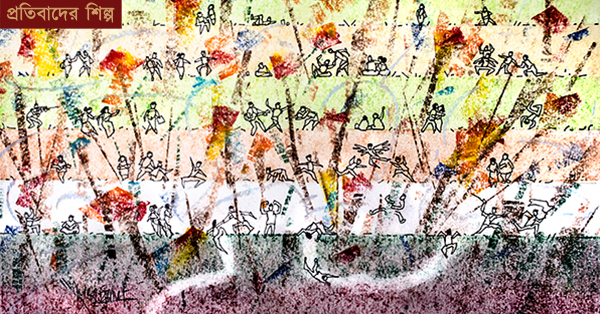Hope and Resurrection

 মালবিকা ব্যানার্জি (Malavika Banerjee) (May 22, 2021)
মালবিকা ব্যানার্জি (Malavika Banerjee) (May 22, 2021)Is time not moving? Or are we on a merry-go-round that makes a raging pandemic intersect a devastating cyclone every summer? Is May the cruellest month then, as we see India’s coasts, both east and west, blasted by vicious cyclones for a second summer? In harm’s way last year was the east coast, with Kolkata and the South 24 Parganas being ravaged by Amphan. India was not yet benumbed by repeated bereavements then; the pandemic had not yet fully launched its own superstorm of grief. This year Cyclone Tauktae is wreaking havoc in Gujarat and other stretches of the west coast. Meanwhile, on the east coast Cyclone Yaas will lash the Sundarbans, south Bengal and Bangladesh next week. Yet, in the case of both cyclones, the toll in terms of lives will be only a fraction of what Covid snatches from us every single day. We live in the times of competing catastrophes.
Looking back at Amphan a year after it howled across Kolkata – felling trees, plucking out windows and morphing kiosks and hoardings into deadly projectiles – two stories emerge. The first is the good news: managed retreat systems (the organised voluntary movement of populations by government away from danger zones during hazardous weather) are in place in all of India’s coastal states. The loss of life in a weaker storm like Aila in 2010 was almost 350. Amphan, the strongest storm in over two centuries had a death toll of around 100. Speaking immediately after the Amphan, eminent author Amitav Ghosh, who has written extensively on climate change and its impact on India’s coastline, said: “Odisha is the world leader in preparedness and evacuation. Kudos to Naveen Patnaik for showing the way.” Extensive evacuations and safe shelters in West Bengal last year ensured that while loss of property was extensive, precious lives were saved. Another important improvement is that our warning systems are becoming more accurate and are coming earlier with each successive storm or cyclone. This, in turn, aids smoother evacuations and more humane facilities in safe houses.
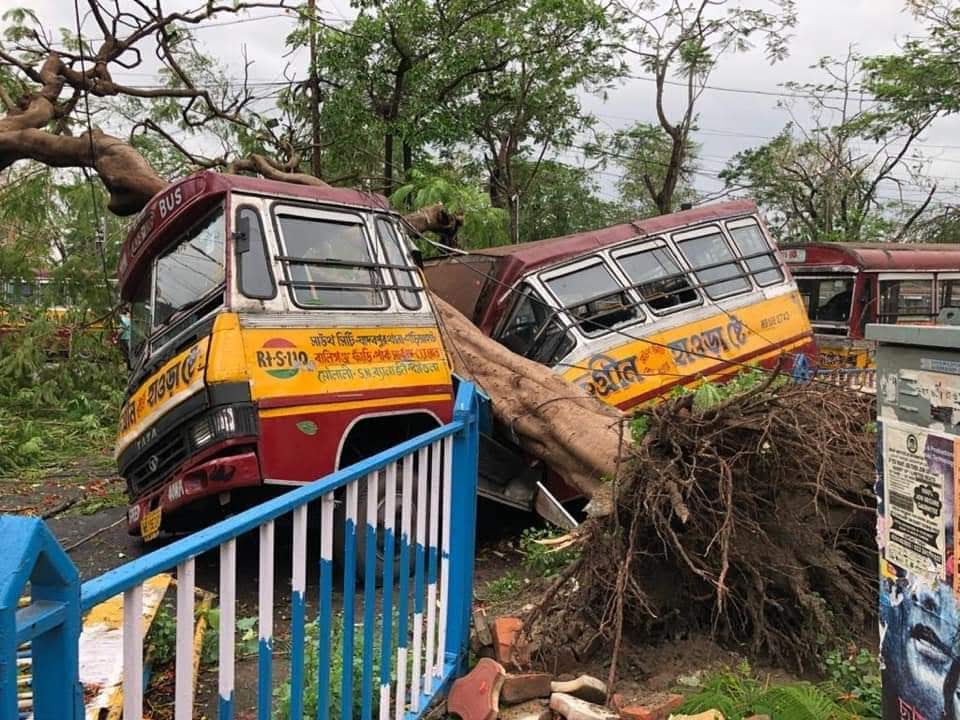
A tree uprooted due to Amphan tears through a parked mini-bus in Kolkata
Photograph by Arka DasThe other story that emerges is that nothing really changes once the storm subsides. Dire necessity leads to villagers returning to their vulnerable homes, and amnesia leads city-dwellers to lapse back to their familiar ways.
The situation in villages like Kultali is partly one of courage, partly of a resignation to fate. Not as remote as other parts of Sundarbans, homes were nevertheless flattened by strong cyclonic winds and the school building was the safe house for the entire population of the village. The villagers were slowly getting back to their dwellings 10 days later, in early June 2020, and life would continue as usual. The men were resuming their trips to the forests seeking honey, the women were back to cultivating chillies, working on kantha embroidery for stores and boutiques in Kolkata. They reckoned that in a month they would have forgotten the storm altogether.
Living on the battlefront of climate conflict has made the people of Sundarbans resilient – these men and women are armed, not with modern tools to protect their belongings, but with the knowledge that storms are part of their reality. That said, migrations have also become a part of the story of the Sundarbans. It is estimated that annually, approximately five lakh young men and women leave this region seeking jobs in the western states of India, several gravitating to tourist hubs like Goa and Kerala. Would planned resettlement (moving the entire population permanently) bring employment and security to the region?
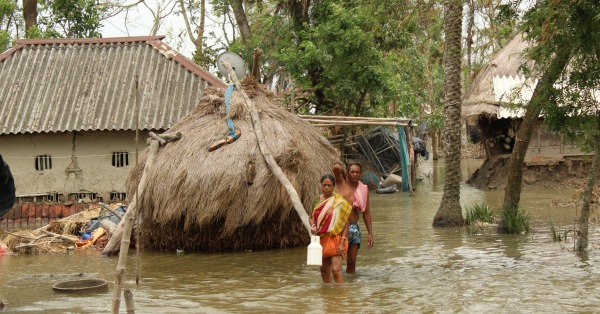
Villages submerged due to Amphan in the Sundarbans Experts are wary of such a solution. Annu Jalais and Amites Bhattacharya, two scholars who have worked extensively in the Sundarbans say: “…as past experiences around the displacement of people linked to India’s various dam-building projects have shown, these dislocations do not usually end well. The vulnerabilities faced by the people of the region are not only due to climate change, nor are they due simply to the lack of infrastructure such as bridges, jetties, hospitals, or brick roads. Instead, they are based on long-term governmental apathy and an utter callousness towards what these islanders are entitled to as citizens.”
Ghosh, too, agrees that relocating populations (a common exercise in countries such as the Netherlands) is fraught with danger. “Government-led evacuations can lead to violent and murderous situations, it is never a good idea,” he said. As things stand, the Sundarbans is a story of resilience born out of necessity. The people here feel they belong to the land, and it is heartening to see how the syncretic community stands together whenever the elements conspire against it.
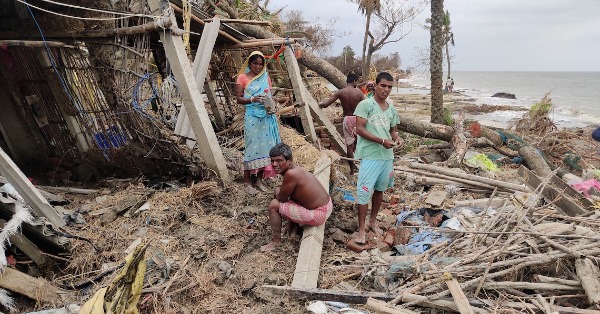
The raging cyclone destroyed lives, livelihood and property in the Sundarbans, the first
line of defence against such natural calamitiesThe story in Kolkata and its suburbs is one of amnesia. Citizens have forgotten that they were without power for more than a fortnight. They have forgotten that trees planted in concrete sidewalks weaken their roots and also endanger buildings and even those who live in those areas. Trees have been planted in exactly the same way once again. They have forgotten the need to ensure that overhead wires are gradually replaced by underground wiring. The pandemic would have been an excellent time to implement underground wiring because of comparatively low vehicular traffic. That opportunity still exists but so do the mesh of wires that dangle over the entire city. Building planners could have learnt that glass frontages on the 22nd floor are not a good idea, but all across India it is still seen as a symbol of posh living.
None of this is peculiar to Kolkata. In fact, Mumbai, Chennai and other seaside cities that are even more vulnerable are also guilty of sticking to the same trappings of modern living.
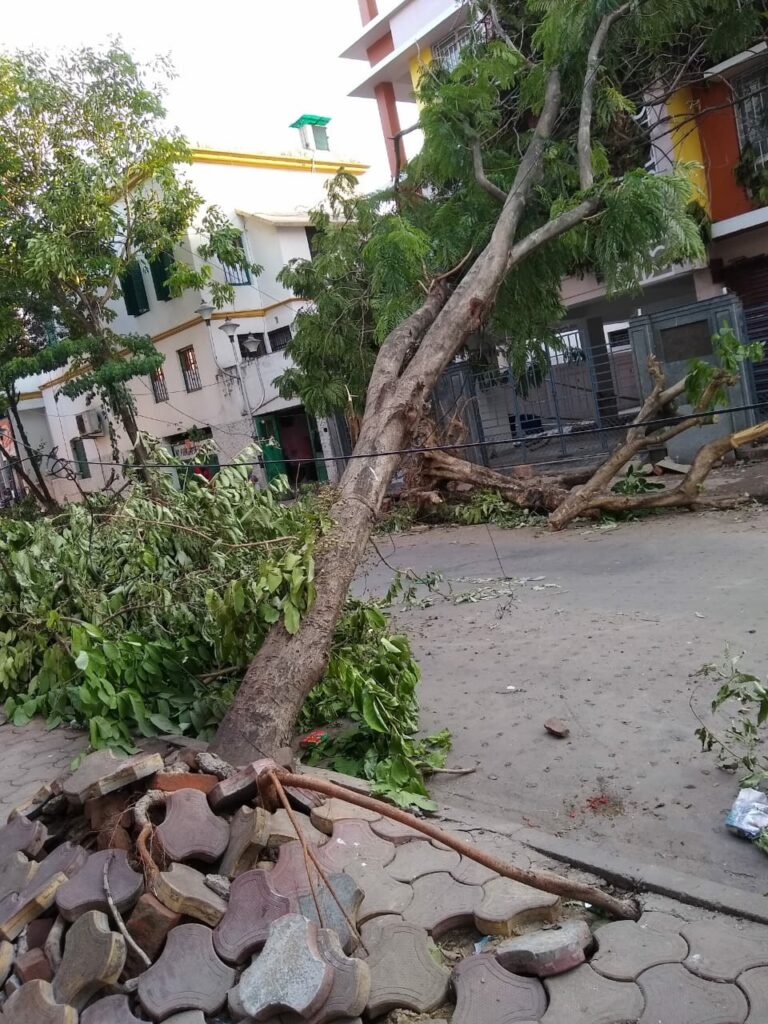
Trees uprooted through the concrete sidewalks and precariously hanging wires dotted Kolkata neighbourhoods the day following the super-cyclone As a year passes since that fateful Wednesday evening, everyone in Kolkata has an Amphan story to tell. I could see a frail banana tree swaying wildly whenever I mustered the courage to peer out at Amphan’s onslaught. An adolescent sapling of around six feet, bunches of fruit fell off its tender stem early in the evening, its flowers looked increasingly bruised. It was clear that the tree wouldn’t survive the night. Next morning, amid all the devastation around it, it stood tilted but still standing.
That tree is now kissing my first-floor window and its broad leaves wrap the paturis that the building residents rustle up every now and then. There is the storm, and then there is the story of regeneration and hope.
Cover photography by Arka Das
পূর্ববর্তী লেখা পরবর্তী লেখা
Rate us on Google Rate us on FaceBook




